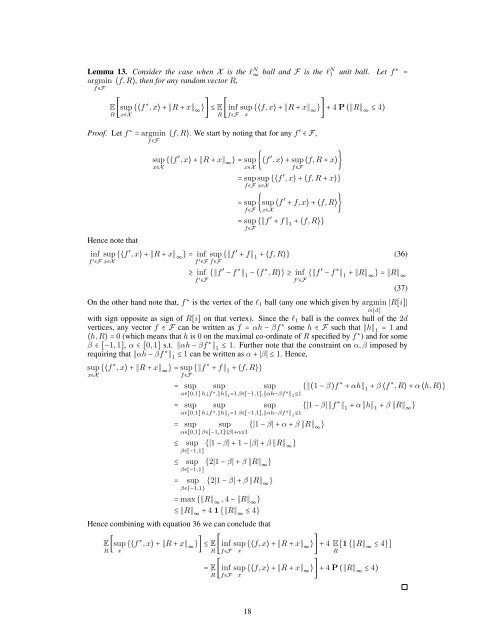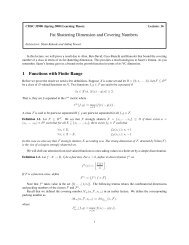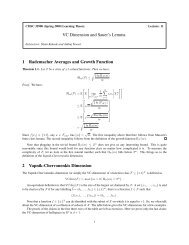Relax and Randomize: From Value to Algorithms
Relax and Randomize: From Value to Algorithms
Relax and Randomize: From Value to Algorithms
You also want an ePaper? Increase the reach of your titles
YUMPU automatically turns print PDFs into web optimized ePapers that Google loves.
Lemma 13. Consider the case when X is the l N ∞ ball <strong>and</strong> F is the l N 1 unit ball. Let f ∗ =<br />
argmin ⟨f, R⟩, then for any r<strong>and</strong>om vec<strong>to</strong>r R,<br />
f∈F<br />
E<br />
R<br />
[sup<br />
x∈X<br />
Proof. Let f ∗ = argmin<br />
f∈F<br />
Hence note that<br />
f ′ ∈F x∈X<br />
{⟨f ∗ , x⟩ + ∥R + x∥ ∞<br />
}] ≤ E [inf<br />
R f∈F<br />
sup<br />
x∈X<br />
sup {⟨f, x⟩ + ∥R + x∥ ∞<br />
}] + 4 P (∥R∥ ∞<br />
≤ 4)<br />
x<br />
⟨f, R⟩. We start by noting that for any f ′ ∈ F,<br />
{⟨f ′ , x⟩ + ∥R + x∥ ∞<br />
} = sup<br />
x∈X<br />
f ′ ∈F f∈F<br />
= sup<br />
f∈F<br />
= sup<br />
f∈F<br />
{⟨f ′ , x⟩ + sup ⟨f, R + x⟩}<br />
f∈F<br />
sup {⟨f ′ , x⟩ + ⟨f, R + x⟩}<br />
x∈X<br />
{sup ⟨f ′ + f, x⟩ + ⟨f, R⟩}<br />
x∈X<br />
= sup {∥f ′ + f∥ 1<br />
+ ⟨f, R⟩}<br />
f∈F<br />
inf sup {⟨f ′ , x⟩ + ∥R + x∥ ∞<br />
} = inf sup {∥f ′ + f∥ 1<br />
+ ⟨f, R⟩} (36)<br />
≥ inf {∥f ′ − f ∗ ∥ 1<br />
− ⟨f ∗ , R⟩} ≥ inf {∥f ′ − f ∗ ∥ 1<br />
+ ∥R∥ ∞<br />
} = ∥R∥ ∞<br />
f ′ ∈F<br />
f ′ ∈F<br />
(37)<br />
On the other h<strong>and</strong> note that, f ∗ is the vertex of the l 1 ball (any one which given by argmin ∣R[i]∣<br />
i∈[d]<br />
with sign opposite as sign of R[i] on that vertex). Since the l 1 ball is the convex hull of the 2d<br />
vertices, any vec<strong>to</strong>r f ∈ F can be written as f = αh − βf ∗ some h ∈ F such that ∥h∥ 1<br />
= 1 <strong>and</strong><br />
⟨h, R⟩ = 0 (which means that h is 0 on the maximal co-ordinate of R specified by f ∗ ) <strong>and</strong> for some<br />
β ∈ [−1, 1], α ∈ [0, 1] s.t. ∥αh − βf ∗ ∥ 1<br />
≤ 1. Further note that the constraint on α, β imposed by<br />
requiring that ∥αh − βf ∗ ∥ 1<br />
≤ 1 can be written as α + ∣β∣ ≤ 1. Hence,<br />
sup<br />
x∈X<br />
{⟨f ∗ , x⟩ + ∥R + x∥ ∞<br />
} = sup {∥f ∗ + f∥ 1<br />
+ ⟨f, R⟩}<br />
f∈F<br />
= sup<br />
sup<br />
sup<br />
α∈[0,1] h⊥f ∗ ,∥h∥ 1 =1 β∈[−1,1],∥αh−βf ∗ ∥ 1 ≤1<br />
= sup<br />
sup<br />
sup<br />
α∈[0,1] h⊥f ∗ ,∥h∥ 1 =1 β∈[−1,1],∥αh−βf ∗ ∥ 1 ≤1<br />
= sup<br />
≤<br />
≤<br />
sup<br />
α∈[0,1] β∈[−1,1]∶∣β∣+α≤1<br />
sup<br />
β∈[−1,1]<br />
sup<br />
β∈[−1,1]<br />
{∣1 − β∣ + α + β ∥R∥ ∞<br />
}<br />
{∣1 − β∣ + 1 − ∣β∣ + β ∥R∥ ∞<br />
}<br />
{2∣1 − β∣ + β ∥R∥ ∞<br />
}<br />
= sup {2∣1 − β∣ + β ∥R∥ ∞<br />
}<br />
β∈{−1,1}<br />
= max {∥R∥ ∞<br />
, 4 − ∥R∥ ∞<br />
}<br />
≤ ∥R∥ ∞<br />
+ 4 1 {∥R∥ ∞<br />
≤ 4}<br />
Hence combining with equation 36 we can conclude that<br />
E<br />
R<br />
[sup<br />
x<br />
{⟨f ∗ , x⟩ + ∥R + x∥ ∞<br />
}] ≤ E [inf<br />
R f∈F<br />
= E [inf<br />
R f∈F<br />
sup<br />
x<br />
{∥(1 − β)f ∗ + αh∥ 1<br />
+ β ⟨f ∗ , R⟩ + α ⟨h, R⟩}<br />
{∣1 − β∣ ∥f ∗ ∥ 1<br />
+ α ∥h∥ 1<br />
+ β ∥R∥ ∞<br />
}<br />
{⟨f, x⟩ + ∥R + x∥ ∞<br />
}] + 4 E [1 {∥R∥ ∞<br />
≤ 4}]<br />
R<br />
sup {⟨f, x⟩ + ∥R + x∥ ∞<br />
}] + 4 P (∥R∥ ∞<br />
≤ 4)<br />
x<br />
18




